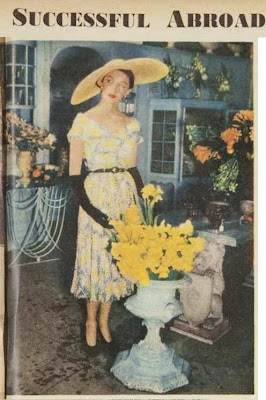Julia Child has had a revival, thanks largely to a recent blog that became a film. Likewise Elizabeth David had a bit of a comeback with new biographies and a telemovie. And despite earlier disgrace, Martha Stewart still manages to hold her own as the domestic guru on craft and interior design as well as the kitchen.
Modern women may be baffled by how much store was once set on the art of flower arranging for the home. Today, no-one would think twice about making up a decorative arrangement that mixes flowers with bits of fruit, grasses, pine cones or feathers, but there was a time when it was frowned upon and considered to be “avant garde” and it was Constance Spry who was instrumental in bringing about that change.
Spry was the Martha Stewart of her day and although she was considered primarily a society florist, she was much more than that.
 |
| The Windsors 1937 (AP image) |
Her most famous early project was probably the design of the flowers for the wedding at Chateau de Cande of the Duke and Duchess of Windsor in 1937 - not a good social move by Spry, given those circumstances - but her status was restored by the time of the wedding of Princess Elizabeth ten years later and the subsequent 1953 Coronation for which Spry designed the flowers in Westminster Abbey, the celebratory dinners and along the processional route. She also often designed arrangements for operas and ballets at Covent Garden.
Spry also ran schools (including the forerunner of the Cordon Bleu School) and gave advice on gardening during war-time when flowers were pulled up in favour of vegetables. But some of her ideas still seem rather outlandish - how many modern brides would consider parsley or cabbage leaves in their bouquets - as was fashionable in the 1930s?
Women living in the British Dominions and Colonies in an era when the mother country England was still treated with deference and awe seemed to be particularly fascinated by Spry and would follow her advice and suggestions slavishly. In certain circles, sending one’s daughter overseas to England to be “finished” at the Constance Spry school was a highly prestigious aspiration.
It is hard to imagine what - apart from flower arranging, deportment, and knowing not to eat peas off your knife - the girls were expected to achieve. Some of these establishments were also called “charm” schools and basically existed to teach frumps how to become sophisticated and cultured (e.g. how to read a French menu and wield a cigarette holder with aplomb) and thereby snag a rich husband.
Research of Australian magazines and newspapers of the day (see TROVE) show numerous reports gushing over the latest Constance Spry publications and endless society column boasts about the lucky ladies about to sail to, or just returned from, study at Spry’s school.
This photo from The Australian Women’s Weekly, 23 March 1955 shows a group of society types at a fashion event in London and in which Australian-born Mrs Vyvyan Holland (her husband was the son of Oscar Wilde) is frightfully game to wear a hat of “real white lilac” made by Constance Spry. We trust there were no bees about!Before dismissing Spry as outdated and inconsequential in this day and age, it is worth considering what she achieved for herself in what was an era of great transition for many women.
In a review of her latest biography by Sue Shepherd, Robert O’Byrne in The Irish Times shows an insight into Spry that has been overlooked.
andSpry’s innovations within her field deserve to be acknowledged, but so too, and more importantly, does her position as a role model for women seeking to take control of their lives.
... But breaking free from the constraints of [her] upbringing, [she] had the foresight to recognise how a natural aptitude could be deployed to generate income and provide employment. Thanks to flower arranging, Spry gained global fame, publishing books and giving lecture tours around the world while running a school where other women could learn the skills that had proven so profitable for her.
In our celebrity-driven age when unkempt chefs compete with each other as to who has the foulest mouth and worst hygiene habits at the expense of the food, and manners and etiquette have become laughable or despised, maybe it would be refreshing to have the wheel turn back a little and a new Constance Spry bring back some elegance and style into our lives.
Click here for a rare Pathe newsreel of 1945 with some of Spry’s design tips.
This blog carries an extensive summary of her important contribution to flower design. And, as keen gardeners may know, Spry was instrumental in saving many rare flowers from extinction and there is a famous rose named after her.
Her 1960 obituary in The Illustrated London News was brief and succinct.




No comments:
Post a Comment